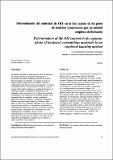Por favor, use este identificador para citar o enlazar a este item:
http://hdl.handle.net/10261/81307COMPARTIR / EXPORTAR:
 SHARE SHARE
 CORE
BASE CORE
BASE
|
|
| Visualizar otros formatos: MARC | Dublin Core | RDF | ORE | MODS | METS | DIDL | DATACITE | |

| Título: | Determinación del contenido de OH en la fase acuosa de los poros de matrices cementantes por un método empírico de lixiviación |
Otros títulos: | Determination of the OH- content in the aqueous phase of hardened cementitious materials by an empirical leaching method | Autor: | Castellote, Marta CSIC ORCID; Alonso, M. Cruz CSIC ORCID ; Andrade Perdrix, Carmen CSIC ORCID | Palabras clave: | Fase acuosa de los poros Iiones hidroxilo Análisis Lixiviación Método empírico |
Fecha de publicación: | 2002 | Editor: | Consejo Superior de Investigaciones Científicas (España) | Citación: | Materiales de Construcción 52(265): 39-56 (2002) | Resumen: | [ES] El método más fiable de determinación de iones hidroxilo
en una fase acuosa de materiales cementantes es la
extracción de la misma mediante aplicación de presión
(pore-pressing). Sin embargo, este método necesita un
equipo especial además de una cantidad de muestra
relativamente alta. En la presente investigación, se propone
la determinación de la concentración de OH' en la fase
acuosa del hormigón mediante un método de lixiviación en
muestra granulada. El programa experimental se ha
realizado a partir de morteros con 5 diferentes materiales
cementantes y tres disoluciones de lixiviado distintas. En el
tratamiento de los resultados, se han considerado
diferentes fenómenos (dilución + disolución de las fases
sólidas) que tienen lugar durante la lixiviación, hasta
llegar a obtener los resultados obtenidos por la técnica de
extracción por presión. La concordancia encontrada es
suficientemente buena para todos los materiales ensayados,
a pesar de que el mecanismo de la extracción no se ha
clarificado en su totalidad y de que son las
concentraciones y no las actividades de los iones las que se
han tenido en cuenta para los cálculos. Por tanto, en esta
etapa de la investigación, el método que se propone se
puede considerar como empírico. [EN] The most reliable method to determine the concentration of hydroxyl ions in the aqueous phase of hardened cementitious materials is the squeezing of concrete at high pressures. However, this method needs special equipment as well as a relatively high amount of sample to be carried out. In present research, the determination of the OH concentration in the concrete pore solution is undertaken by a leaching method in granulated samples. The experimental program has been made using mortars with 5 different binders and three different leaching solutions. In the treatment of the results, different phenomena (dilution + dissolution of solid phases) occurring during leaching have been taken into account until reaching the target values validated by comparison with those obtained by means of the high pressure technique. The agreement found is good enough, for every binder tested, in spite of the fact that fully understanding of the leaching mechanism is not achieved and that concentrations and not activities of the ions are taken into account in the calculations. Therefore, the method suggested is empirical at present stage. |
Versión del editor: | http://dx.doi.org/10.3989/mc.2002.v52.i265.343 | URI: | http://hdl.handle.net/10261/81307 | DOI: | 10.3989/mc.2002.v52.i265.343 | ISSN: | 0465-2746 |
| Aparece en las colecciones: | (IETCC) Artículos |
Ficheros en este ítem:
| Fichero | Descripción | Tamaño | Formato | |
|---|---|---|---|---|
| andrade_03-09-2013.pdf | 2,81 MB | Adobe PDF |  Visualizar/Abrir |
CORE Recommender
SCOPUSTM
Citations
10
checked on 21-abr-2024
WEB OF SCIENCETM
Citations
7
checked on 25-feb-2024
Page view(s)
385
checked on 24-abr-2024
Download(s)
1.025
checked on 24-abr-2024
Google ScholarTM
Check
Altmetric
Altmetric
Este item está licenciado bajo una Licencia Creative Commons

